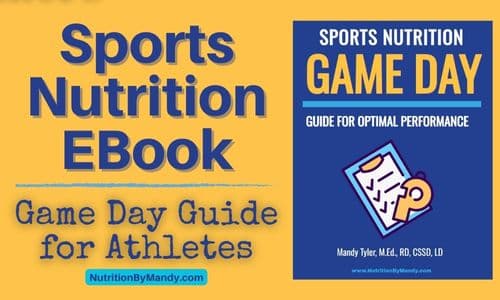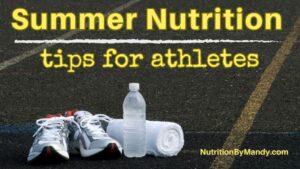Last Updated on September 20, 2024 by Mandy Tyler, M.Ed., RD, CSSD, LD
Lacrosse Nutrition: 5 Tips for Optimal Performance
It is important for lacrosse players to know how to fuel their bodies for optimal performance.
Let’s take a look at the energy demands of lacrosse. Then we will explore five lacrosse nutrition tips to help keep athletes fueled all season long.
Energy Demands of Lacrosse
Lacrosse is a competitive team sport in which athletes need strength, endurance, and speed to excel on the field.
Throughout the lacrosse match, athletes must make sudden, frequent changes in direction and engage in high-intensity sprints, requiring athletes to have both agility and stamina (1, 2).
Athletes must also have coordination and power to effectively maneuver the lacrosse stick to pass, carry, catch, and shoot the ball (1). Lacrosse is a physically and mentally demanding sport, thus it is essential for athletes to have a sports nutrition plan in place to support their health and performance needs.
Lacrosse Nutrition: 5 Tips for Optimal Performance
Now that you understand the high-energy demands of the sport, let’s look at five nutrition tips for lacrosse players.
Lacrosse Nutrition Tip #1: Fuel Your Activity with Carbohydrates
Carbohydrates provide the body with the energy needed to perform at its best. Thus, carbohydrates should be at the foundation of a lacrosse player’s meal plan.
Prior to a lacrosse match, athletes should eat a pre-game meal that is high in carbohydrates and contains a moderate amount of lean protein. When possible, this meal should be scheduled 3-4 hours prior to the start of the competition.
Example pre-match meals for lacrosse players include:
- Pancakes, scrambled eggs, and fresh sliced fruit
- Fruit smoothie, bagel with nut butter
- Turkey sub sandwich, pretzels, grapes, sports drink
- Pasta with turkey meatballs and marinara sauce, bread sticks, fresh fruit cup
- Grilled chicken, rice, fresh mixed berries, dinner roll
With the pre-match meal, athletes should limit their intake of foods too high in fiber and/or fat. Consuming foods high in fat and/or fiber, too close to the start of the activity, may result in GI distress during the event (3).

High-Carbohydrate Pre-Match Snacks
In the hour leading up to the lacrosse match, athletes should focus on consuming high-carbohydrate snacks, which will provide extra energy in the upcoming competition.
Example pre-match snacks for lacrosse players include:
- Banana or small piece of fruit
- Applesauce squeeze
- Dried fruit, fruit leather, fruit snacks
- Pretzels, pita chips, animal crackers
- Fig bar, low-fat granola bar, mini bagel
- Sports drinks, chews, gels
Lacrosse Nutrition Tip #2: Focus on Recovery Nutrition Following Lacrosse
Once lacrosse season begins, it is not uncommon for teams to play several matches per week. When athletes have limited time to recover between events, it is important they have a plan in place to support their recovery nutrition needs.
The three goals of recovery nutrition include:
- Rehydrate: Replace fluid and electrolytes lost in sweat
- Refuel: Refill carbohydrate energy stores
- Repair: Consume protein to build and repair muscle
Recovery Nutrition Snack Ideas for Lacrosse Players
Following a lacrosse match, eating a well-planned post-game snack can support an athlete with meeting their recovery nutrition needs.
Eating a post-match snack is particularly important when it will be several hours until an athlete eats their next meal.
Ideas for snacks following a lacrosse match include:
- Low-fat chocolate milk and granola bars
- Peanut butter and jelly sandwich with low-fat milk
- Greek yogurt, berries, and granola
- Ham and cheese wrap with sports drink
- Trail mix with pretzels, dried fruit, nuts, and dry cereal with sports drink
- Breakfast bars with nut butter and a banana
- Pretzels, jerky, and sports drink
- Post-workout fruit smoothie

Post-Match Meals for Lacrosse Players
When possible, lacrosse players should follow-up their snack with a post-game meal. The meal should be high in carbohydrates and contain lean protein to further support the athlete’s recovery nutrition needs.
Example post-game meals that lacrosse players can enjoy include:
- Pasta with grilled chicken and tomato sauce, garden salad, breadsticks, low-fat milk
- Burrito bowl with rice, chicken, black beans, corn salsa, guacamole and a sports drink
- Grilled pork chop, sweet potato, grilled asparagus, fresh sliced fruit, tart cherry juice
- Grilled salmon, brown rice, steamed broccoli, fresh berries, dinner rolls, 100% fruit juice
Lacrosse Team Post-Match Meals
When planning team meals for away games, it is important to keep the recovery nutrition needs of athletes in mind.
Consider the following post-match meal ideas that can be ordered from restaurants:
- Panera – Breakfast, sandwiches
- Chick-fil-A – Grilled chicken sandwiches and wraps, fresh fruit cups, fruit and yogurt parfaits
- Chipotle – Burritos, burrito bowls
- CAVA – Grain bowls, pita wraps
- Jason’s Deli – Breakfast trays, sandwiches, pasta, potatoes
- Jersey Mike’s – Sub sandwiches
- Pei Wei – Asian food boxed meals
Lacrosse Nutrition Tip #3: Make Hydration a Priority
The next nutrition tip for lacrosse players is to make hydration a daily priority. Dehydration can negatively impact an athlete’s health as well as sports performance.
Thus, it is important for lacrosse players to start a lacrosse match in an optimally hydrated state.
Hydration Prior to a Lacrosse Match
Although hydration needs vary amongst athletes, there are some general pre-event guidelines athletes can follow.
Approximately 4 hours prior to the event, it is recommended that athletes drink 5-7 mL of fluid per kg of body weight (4). For a 175-pound athlete, this calculates to be ~13 – 19 fluid ounces.
Thus, consuming approximately 2 cups of fluid (16 fl oz) with the pre-game meal can help athletes with meeting this hydration goal.
Athletes can continue hydrating with water or a sports drink in the hour leading up to the competition, drinking approximately 8 oz of fluid during this time period.
Hydration During the Lacrosse Match
During activity, athletes sweat to remove heat from their bodies. When athletes sweat, they lose both fluid and electrolytes. Therefore, the goal during activity is to minimize the amount of dehydration that occurs due to sweat losses (5).
Athletes vary greatly in regard to the amount of fluid and electrolytes lost in sweat. However, a general recommendation during activity is for athletes to drink ~3-8 ounces of fluid every 15-20 minutes (0.4-0.8 L per hour) of activity (3, 4).
Drinking a big gulp of water or sports drink is equivalent to approximately 1 ounce of fluid. Thus, lacrosse players should aim for several big gulps from their water bottle every 15-20 minutes of activity or every time they come off the field during competition.
As a reminder, these are hydration guidelines for athletes. Given the variability in sweat losses, it is best for lacrosse players to work with a sports dietitian nutritionist to develop an individualized hydration plan that meets their specific needs.
Hydration Following a Lacrosse Match
Following a lacrosse match it is important for athletes to rehydrate and replace the fluid and electrolytes lost in sweat.
Weighing before and after activity can help athletes determine how much fluid was lost in sweat. For each pound of weight lost during the activity, athletes should aim to drink 20-24 oz of fluid (3).
Consuming sodium in food and drinks following activity can help athletes with replacing the sodium lost in sweat. In addition, sodium helps athletes to better retain the fluid consumed after exercise (4).

Lacrosse Nutrition Tip #4: Avoid Underfueling
Lacrosse is a high-intensity, energy-demanding sport. Research looking at the nutritional intake of female collegiate lacrosse players has found that this group is at risk for underfueling. The female athletes studied consistently consumed less energy in their diet than they expended through activity, resulting in a calorie imbalance and low energy availability (6).
By underfueling, a lacrosse player is at risk for a variety of potential health and performance concerns such as (7, 8, 9):
- Nutrient deficiencies
- Disruption of the menstrual cycle in females
- Low bone density leading to increased risk of stress fractures
- Reduced metabolic rate
- Decreased strength and endurance
- Difficulty concentrating
- Reduced response to training
Relative Energy Deficiency in Sport (REDs)
Relative Energy Deficiency in Sport (REDs) is the term used to describe the syndrome of concerns resulting from low energy availability (8).
Although REDs appears to be more prevalent in females (9), it is important to recognize that a calorie imbalance and resulting energy deficiency can occur in both male and female athletes.
It is important for lacrosse players to be aware of the impact that underfueling can have on both health and performance. Consuming adequate calories is paramount to promote an athlete’s health as well as optimal sports performance.
Lacrosse players at all levels should be educated on the importance of consuming adequate calories to fuel their bodies to perform at their best.

Lacrosse Nutrition Tip #5: Be Prepared for Travel
Once the season begins, lacrosse players frequently travel to out-of-town competitions. Thus, it can be helpful for athletes to have travel nutrition strategies in place to help meet their sports nutrition needs while on the road.
Prior to leaving on the trip, athletes should plan ahead and pack snacks they can enjoy on the bus. If traveling by plane, athletes should take airplane snacks that comply with TSA regulations.
In addition, athletes should bring an empty water bottle they can refill once going through the security check-point, which can help them stay hydrated on the trip.
Athletes should also consider what food they want to have available in their hotel room for quick snacks and meals during their stay.
Healthy Choices When Eating Out
Finally, athletes should be equipped with ideas for making healthy choices at restaurants to support their sports nutrition needs.
Check out my Fast-Food Healthy Eating Out Guide for Athletes, which provides ideas for healthy options for athletes at a variety of types of fast-food restaurants.
Lacrosse Nutrition: 5 Tips for Optimal Performance
You are now equipped with five lacrosse nutrition tips to support an athlete’s health and performance.
For additional sports nutrition recommendations for athletes, read my blog on 11 easy dinner ideas for athletes.
Join the Nutrition By Mandy Email List & Get a Free Athlete’s Grocery List
Click HERE to join the Nutrition By Mandy e-mail list. When you join you will receive a free athlete’s grocery list to print and take with you to the store.
About the Author
Mandy Tyler is a Sports Dietitian Nutritionist in the San Antonio, TX area. She is a Registered and Licensed Dietitian, a Board-Certified Specialist in Sports Dietetics, a Licensed Athletic Trainer, and is a Certified Exercise Physiologist through the American College of Sports Medicine. Mandy has experience working with athletes at the high school, collegiate, and professional levels. She believes the key to reaching one’s full potential, both in everyday life and in sports performance, relies on a healthy nutritional foundation.

If you are looking to take your performance to the next level, make sure to check out my new Sports Nutrition Game Day Guide. This downloadable guide is written to help athletes develop an individualized plan to achieve peak performance on game day






